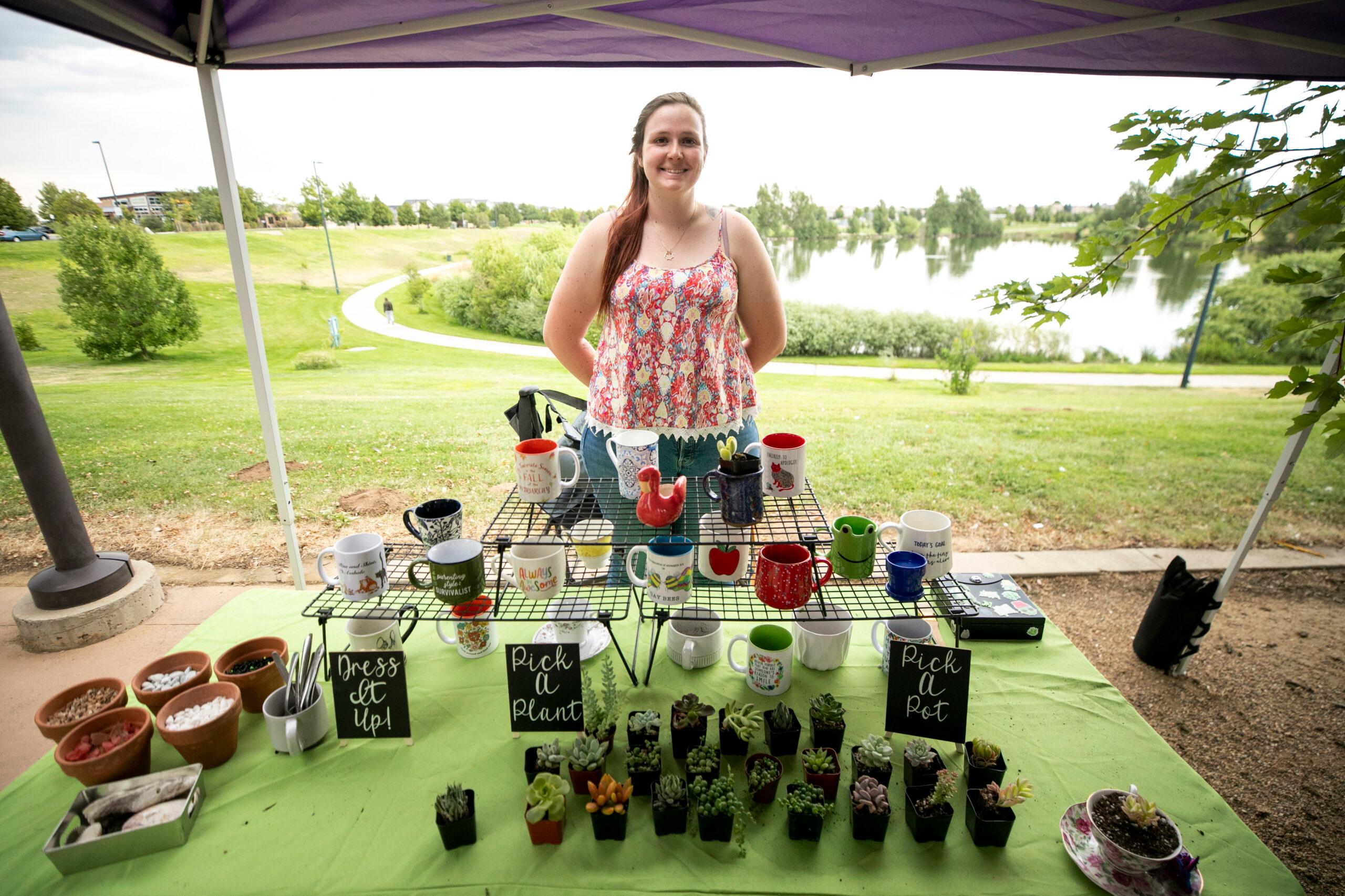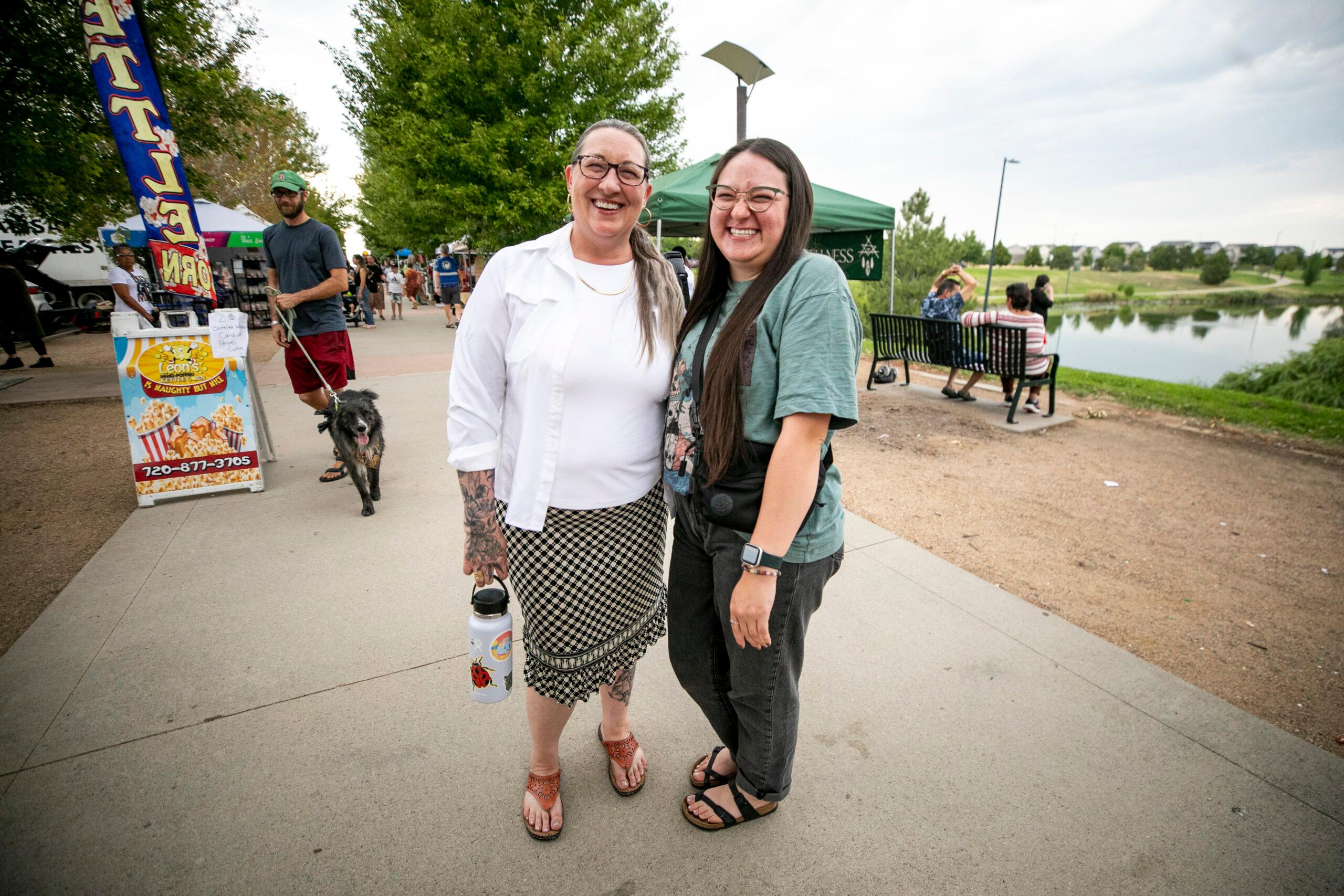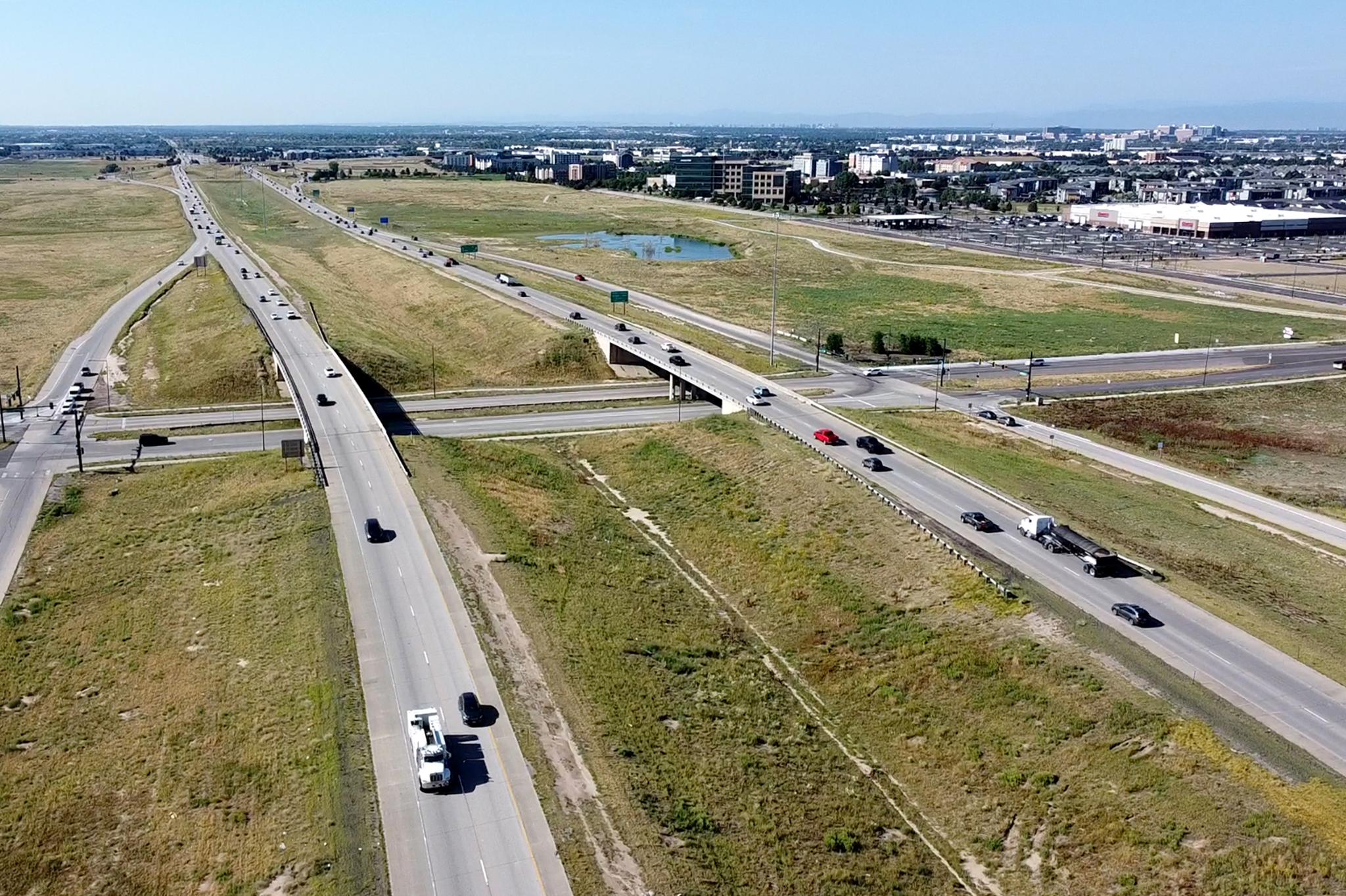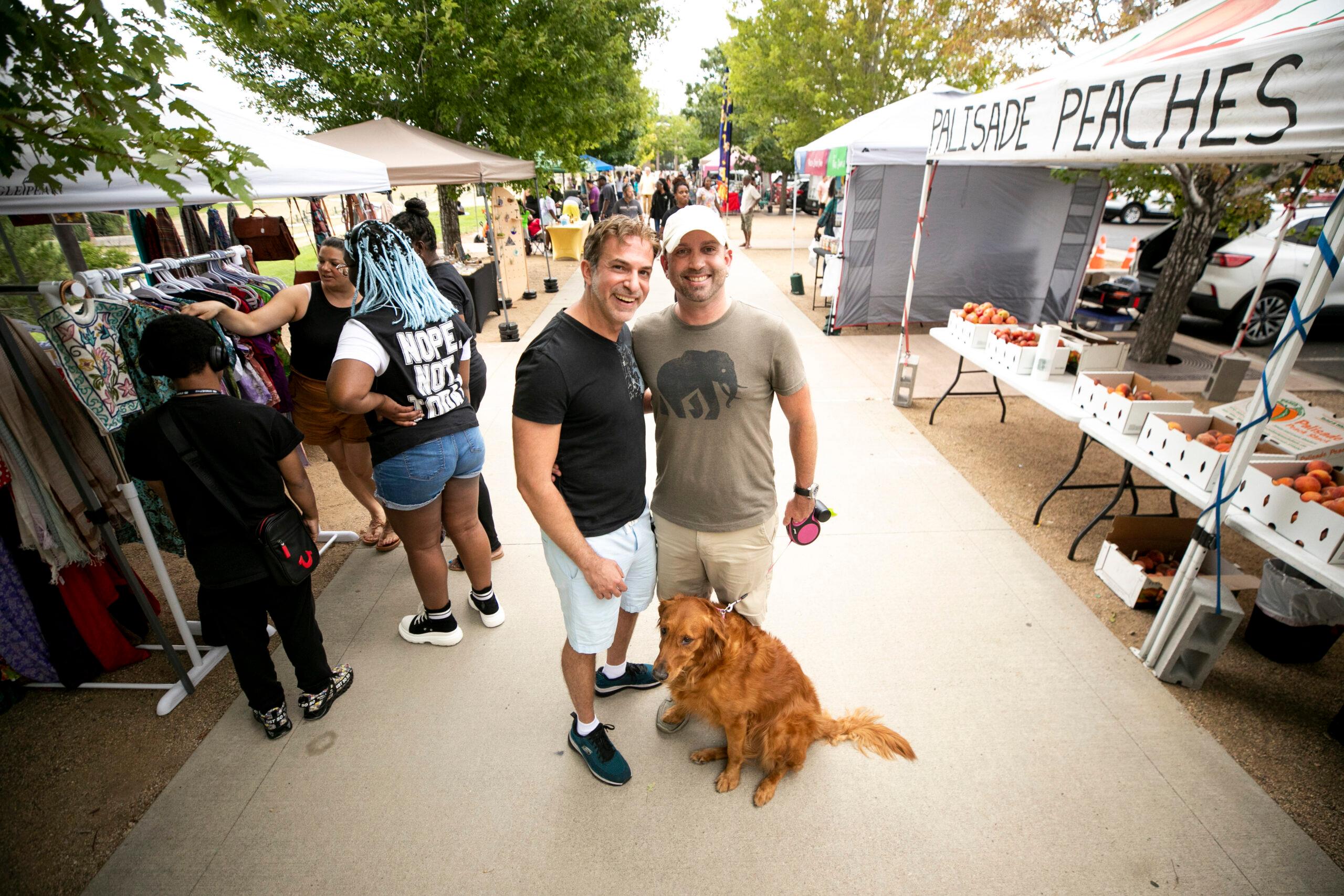The Green Valley Ranch Farmers Market takes place in a picturesque and relatively quiet park overlooking a pond and dozens of new suburban-style houses, symbolic of the neighborhood's ongoing growth.
Just next door is Peña Boulevard, the often traffic-clogged highway leading to and from Denver International Airport (DIA). Most Denverites know it is to be avoided during rush hour unless absolutely necessary.
But for residents in Green Valley Ranch and Montbello, it's the main neighborhood throughway that, in some residents' telling, they have no choice but to use.
In this suburban-style neighborhood, cars are often the most time-effective way to get around. And like many suburbs in Denver and across the U.S., the area lacks a comprehensive public transportation network. Many people Denverite spoke to from the neighborhood said that relying solely on public transportation to get to work is just not feasible.
"Two lanes is not enough for one of the busiest airports in the world," said Sarah Cobb, a Green Valley Ranch resident.
With the airport and surrounding area growing fast, DIA officials are pushing for a wider Peña Boulevard to manage traffic. But some city leaders and advocacy groups argue that an expansion undermines Denver's climate goals. They're calling for more investment in the Regional Transportation District's (RTD) A-Line and other transit instead.
In the middle of that debate are more than 60,000 residents who live right next door to both Peña and the A-Line. Denverite wanted to know: What do they think?

To community members at the farmers market, additional lanes seem like a good idea.
We talked with nearly a dozen Green Valley Ranch residents about the state of transportation and life near Peña Boulevard. They all complained about traffic, and most expressed support for added traffic lanes.
"I'm for it, I'm for the building," said Lizeth Huerta. "Since we live over here, it takes a while to get home."
Cobb commutes from Green Valley Ranch to Tennyson Street in near West Highland for work, and called plans to widen Peña a "spectacular idea." "I drive myself everywhere, I don't take public transportation because I have to drive to the other side of Denver," she said.
While the A-Line can be great for people heading to the airport, Cobb said it just does not work for commuters like her. According to RTD's trip planner, taking RTD from her house to her job at Call Your Mother Deli would take a minimum of 95 minutes, and require two to four buses and trains and up to 40 minutes of walking. Instead, Cobb drives, which takes between 30 to 90 minutes depending on traffic.

Pushing drivers from other parts of the city to the A-Line could clear up space on Peña Boulevard for local residents, but with the pace of growth at the airport and the surrounding area, it's not clear how much that would alleviate traffic for community members.
Councilmember Stacie Gilmore, who represents Green Valley Ranch and part of Montbello, the neighborhoods closest to the airport, said she wants Denver to plan for the future with multi-mobility options in mind, which could include trains and buses but also potential additional toll or carpool lanes.
"When I talked to residents who reside in Green Valley Ranch, or Montbello, we're trapped, we can't get in and out of our neighborhood like other communities," she said.
Gilmore worries about emergency vehicles' ability to navigate the area when traffic hits a standstill, and for community members' ability to evacuate during a potential emergency.
"We need different options, or unfortunately, I think it's going to lead to involuntary displacement of folks who can't get to work on time, can't get to their construction job, etc., etc., to get in and out of the neighborhood."

People who expressed support for widening Peña recognized the environmental consequences. But the situation feels like a lose-lose.
"Is it really all that different than a whole bunch of cars being clogged up in the same space for an hour at a time while they wait for it to clear out?" Cobb asked. "I definitely care about the environment. But at the same time, I'm not going to sit in my car for an hour and a half just to get on to Peña."
It's an argument some proponents of additional lanes make: that faster-moving traffic will lower exhaust as cars sit on the highway. But a number of studies show that more lanes often just mean more cars on the road and more traffic in the long term.
When thinking about environmental impacts, some community members' concerns centered around preserving green space and getting sufficient local input.
"I think it's good, I think it has to be done in an equitable manner," said Joe Rogers, who lives in Green Valley Ranch and recently finished a master's degree in community development, often studying his own neighborhood.

Some highway projects have harmed communities of color in Denver and across the U.S. Rogers acknowledged the troubled history of highway building, but said that's not the case along Peña.
"Out here there's enough space that you could probably widen it," he said. "With more pavement, there's urban heat impacts, there's stormwater runoff. Those are the environmental impacts and community impacts that you have to deal with."
Hannah Miles, who also lives in the area, said wants to see more bus service, but said she feels like a car is still needed. Until transit is more reliable, she asks, "What do we do?
"We have to try to get people to where they need to go ... I don't know," Miles continued.
Opponents to Peña's potential expansion want leaders to invest in A-line improvements instead. For these Green Valley Ranch residents, the two options are not mutually exclusive.
Many residents said they want to see better public transportation and another lane along Peña Boulevard.
Community members appreciated taking the A-Line to things like sporting events or concerts. They did not necessarily feel like a rail line meant to take people to and from the airport was built for everyday community needs.
"The A-line is a nice feature to have going from downtown to the airport, but bus transportation is not the best here. I think we could deal with a lot more connectivity all around," Rogers said. "I know we're doing things to lessen that impact of cars and stuff, but right now with the way Denver, the airport is, and it's getting busier, it's going to be hard to mitigate traffic without widening it, and without extra rail lines coming in."
Still, residents say they want more A-line service configured to serve the everyday needs of people who live in the area, not just people who need to get to the airport.
Mike Socha said he wants to see more stops and lower fares. Since he lives so close to the airport, it is cheaper for him and his partner to split an Uber than pay $10.50 per person to ride the A-line for two stops.
"I think there should be more stops on the A line, they're very far between," he said. "I think it should run more regularly."

With more growth on the horizon, traffic problems in the area have the potential to get worse.
Peña Boulevard was first built in 1993, along with the new airport which opened in 1995. Since then, DIA has grown into the world's third-busiest airport, preparing to reach 100 million annual passengers in the coming decade. Plus, Coca-Cola, Pepsi and United Airlines have all announced plans to expand company operations in the area. Montbello has also had some of the biggest growth in housing in the past 10 years.
DIA already widened part of Peña Boulevard closest to the airport in 2019. Now, DIA is in a public comment period about the rest of the road, where officials solicit community input and research other options. But the city seems headed in the expansion direction, with initial plans adding what will likely be a toll lane that transit buses could also use.
DEN CEO Phil Washington told Denverite this month that the airport supports public transit but also wants a "very responsible" expansion of the highway.
The Denver Regional Council of Governments, which sets long-term transportation plans for the area, recently approved the direction of $5 million in federal money to Peña Boulevard planning. Nearly 300 people signed a petition from Denver Bicycle Lobby to Mayor Mike Johnston opposing that move.
"I wouldn't be opposed to us looking at better infrastructure on our existing roadways, but I haven't seen how we can increase that capacity either to deal with the very real concerns," Gilmore said.
One Green Valley Ranch community member proposed an entirely different idea: reconfiguring Peña to serve locals and airport-goers in different ways. Mike Socha gave the example of Virginia State Route 267 near Washington D.C., which reserves one lane for commuters and one lane for people traveling to Washington Dulles International Airport.
"We are extremely pro-train," said his partner Matt Socha. "Having a really awesome infrastructure and train at a decent affordable price would be ideal, and we're just not there yet."
CPR reporter Nathaniel Minor contributed reporting.














